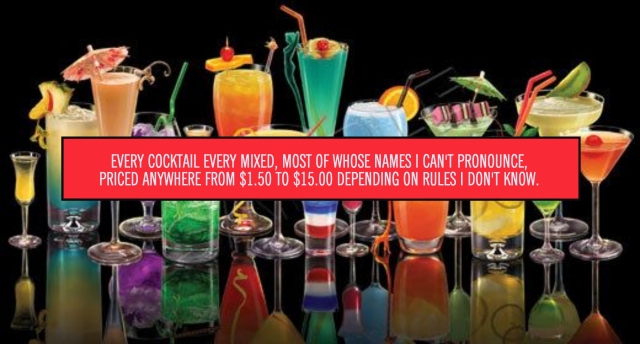Something from the bar?
This has to be the lamest question ever uttered, and it’s uttered a million times a day in restaurants all over the world.
It might elicit an actual drink order from a customer who always wants the same refreshment before dinner, but for everyone else it causes hesitation, confusion, reluctance, panic.
We don’t know what you have, how it’s priced, whether your bartender is frugal or licentious, which of the countless ways you might want to take advantage of us is in play . . . .
In other words, it creates an environment precisely the opposite of what the server intended, which was to make the customer comfortable, appreciated, and catered to (in a word, spendy).
Get it? 🙂
Here’s what your customer at Table 13 visualizes when you attack her with your demand that she order a drink:

It’s no wonder that, when you make her select from this ridiculous array of alternatives—on a strict social deadline!—she panics in the moment and says the only safe thing: “I’ll stick with water.”
And you wonder why you don’t get bigger tips!
Hint to the metaphor: Readers do the same thing. Faced with too much new data or too many choices—in absence of clear guidance—they retreat to their bunkers where you can’t begin to persuade them.
How to Serve
You don’t understand your job, which is to serve, and by serving to guide, and by guiding to sell, and by selling to improve your employer’s bottom line, and—by helping out absolutely everybody—to take home bigger tips from happier customers whose enjoyment has been lubricated by expensive cocktails.
The best servers use their power to their advantage.
And when I say “servers” I mean “writers.” You understand this is an extended metaphor, right?
- They are the subject matter experts
- They have already examined the pertinent evidence
- They have come to the right conclusions
- If they establish your trust, they can guide you to the right conclusions
- Everybody is happy when you come to the right conclusions
How to Write
How to serve; how to write; they come down to the same set of rules. Stay in charge of the subject matter; approach it like the expert you are; guide your reader (diner) to the right conclusion.
One of the images below demonstrates the right way to offer up appetizers. The other is the way we write too often without even knowing we’re doing it.

Get it? 🙂
NOTHING is accomplished if I tell you “We have a wonderful assortment of delicious appetizers; what do you want?”
But if I extend to you a limited sampling of carefully selected delicacies (by which I mean data and evidence because we’re still talking about writing, remember?) and stand there smiling, offering by my benevolent presence to guide you through the options with pleasant but persistent patience, then we pretty much both understand you’re going to order one of these little beauties . . . probably the one on which the house earns the biggest markup.
Get it now? 🙂
Lessons from the Server
NOT TO DO
- Don’t ask open-ended questions.
- Don’t promise that you’ll have important information to share . . . later.
- Don’t blame the kitchen.
- Don’t apologize for what you don’t have.
- Never contradict your customer’s preferences.
TO DO
- Instead of open questions: We have spectacular cocktails from our certified mixologist (I know. I didn’t know there was such a thing either, but she has the certificate to prove it! 🙂 ) But if you’re not drinking, I have flavored teas, a full line of soft drinks, fresh coffees and teas. I’ll even put a big bottle of sparkling water in a bucket of ice. (But I won’t let you think that “sticking with tap water” is an alternative.)
- Instead of saying there are countless options: For big appetites I have a 22-ounce porterhouse; South Jersey magazine raves about our chicken Parmesan; but the best bargain on the menu is the brick oven pizza: 15 bucks and you’ll take half of it home.
- Instead of blaming the kitchen: We’re not used to being so crowded on a Thursday, but the review that came out in the local paper has us really hopping.
- Instead of saying the owner forgot to order seafood: There are no good mussels in the market this week after that storm in the Gulf; fortunately, the Maine lobster was unaffected and the 2-pounder is on special.
- Instead of arguing about your customer’s favorite cut: A lot of people say that, and I agree, so this is hard for me to say, but the filet mignon actually has less flavor than the rib-eye which benefits from all the marbling. Our chef handles both cuts really well. Want to try something new?
Metaphorical Payoff
Do I really have to do this, or do you get it?
- THE KITCHEN is NOT the entire world of knowledge. It’s whatever you’ve been able to gather from your research. You’ve had just a few weeks, for crying out loud. It’s everything you could afford, and everything you could keep from spoiling in your limited refrigerator space (your White Paper; your Brain).
- THE CHEF is you back there working with dull knives and too little butter on the one working burner that isn’t devoted to all your other classes—the ones that really matter to your major! 🙂
- THE SERVER is also you. Once you graduate, you can hire someone to do the serving for you, but for now, you have to cook and deliver everything to the table.
- THE CUSTOMER is your reader. He’s an arrogant blowhard, full of opinions about what’s good and what’s bad about food. You have to figure out what he thinks he knows, charm him into questioning where he got that misinformation, and sell him that the Tortellini-Tre-P that he always thought was cruel to animals happens to be an ecological blessing in exactly three ways, which you delineate for him with pleasant and persistent patience.

Everybody wins.
You collect the big tip for introducing him to guilt-free sausage. He goes home with his utterly infatuated date who has no idea what she’s in for, and you—with your obvious command of the data—attract the attention of the stunning brunette with the dangling earrings and those magnificent teeth.
For sticklers keeping score: Yes. You win twice. But it cost you a semester and he only had to pay the check. Fair’s fair.
Feedback, please
If this is exactly like the advice you’ve received in every other writing class you’ve taken, I’d love to hear about your earlier experiences.
If, on the other hand, it’s a fresh way to consider the task of crafting an academic essay, well, I’d love to hear that too.

I always focused just on my own side and what I was trying to argue, rather than thinking about the reader. This is a good way to look at writing though and I believe it will be helpful when writing in the future.
LikeLike
This along the same lines of what I have heard in previous writing classes, but was never explained through a real life situation and analogy like that which made it easier to understand the goals of writing.
LikeLike
I think this is a very fresh way to look at writing an essay. This makes you think about all of the things that go into persuasion and the areas that you need to pay attention to when writing a convincing essay.
LikeLike
This is different than other lessons on how to write an academic essay. Most other writing classes I have taken focus more on just gathering a large number of sources and echoing what other people already think instead of focusing on how to use sources to bring something new to the conversation and make it digestible for the reader.
LikeLike
I definitely have not heard this advice from any other writing class, but I love this analogy because I have worked as a waitress and it is very similar to winning an argument with a reader.
LikeLike
This was a nice and unique way to look at writing. No one has connected serving and writing together to me. It made it easier and more understandable to follow and actually comprehend what you’re talking about.
LikeLike
This is most definitely a refreshing way of looking at how to propose our ideas. I do like the idea because the person we are serving does not know what’s available so providing them ideas and choices is the best line to convince them to buy something. Pushing something is not going to convince the person we are serving to choose, but rather push back.
LikeLike
I actually never heard of this analogy before today’s class. I thought it was really intriguing to compare writers to chefs and servers in a restaurant or bar and the customers to the readers. This lesson was very helpful and made me see writing in a whole new perspective.
LikeLike
I wasn’t talked about this before and we never really used this analogy ever before in my writing.
LikeLike
I especially like the advice of focusing the attention. While it’s not something that is necessarily new to me, this is something I struggle with. I tend to write too much. So hearing it with this analogy it helped a lot!
LikeLike
To be honest I’ve never really considered this way (the kitchen/serving) of looking at writing. That your trying to convince the reader to buy into the expensive choice rather than the cheap one. Its a pretty good idea and I truly think it’ll help me down the road.
LikeLike
Looking at writing this way, is defiantly a refreshing way of looking at how our ideas will affect how our readers will look at them. I have never had a professor that connected writing and service before. This way made it easier how if you show your vague point of the essay it will overwhelm the reader.
LikeLike